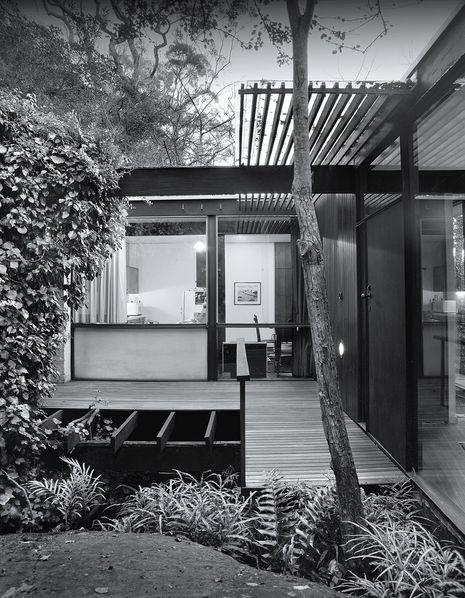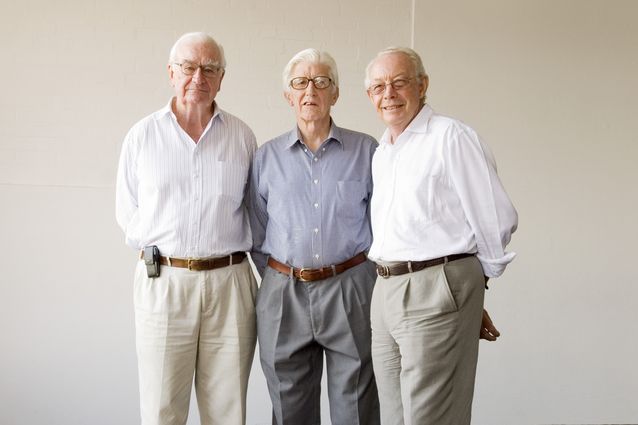Russell Callam Jack commenced his architectural studies at the Sydney Technical College (STC) in 1946, following several years in the RAAF. A gifted student, he won the Byera Hadley Travelling Scholarship on graduation, travelling in Europe and working in London before returning to Australia at the end of 1953.
In Sydney, he worked for Rudder Littlemore and Rudder for two years before going into practice with John Allen (1926–2022), an STC classmate who also had worked at Rudder Littlemore and Rudder.
In 1957, the Jack House in Wahroonga, New South Wales, which Russell and his architect wife Pamela Jack had designed for themselves, was awarded the prestigious Sulman Medal, and this brought Russell wide acclaim. Set on a steeply sloping block and straddling a rocky creek, this house, with its oiled timber framing and bagged brickwork inside and out, was the first of many Jack houses that were the forerunners of what became known as the Sydney School of architecture.

View gallery
These houses consistently used a similar logical expression of structure and detail but differed in their response to individual site aspect and prospect. They also continued Russell’s exploration of the role of a protective masonry wall delineating the boundary between public and private space.
While often included as a member of the Sydney School, Russell’s work was never quite as rugged or as brutal as that of some of the other exponents. The entry path to the Jack House even has a slightly romantic touch, and his interiors were often more sophisticated, containing the odd quirky element, and elegant, refined furniture.
In 1957, I joined the John Allen and Russell C. Jack office as a third-year part-time student. I had previously worked at Fowell, Mansfield and Maclurcan, a relatively large and conservative firm, where I had soaked up traditional detailing, but now thought a smaller office would provide more drawing-board experience. I arrived just as the Jack House was being completed and was blown away by a new way of seeing things, a new view of architecture. I was quickly given the experience I sought, and both John and Russell were excellent and willing teachers. Russell, in particular, was a constructive critic, with a sharp mind and a rare ability to move from the big picture to the detail and simply convey his message.
Several months later, I was joined in the office by two other friends and part-time students, Brian Mazlin and Glenn Murcutt, and they similarly benefitted from Russell’s keen observation and constant guidance. In her 1990 book Australian Architecture Since 1960, Jennifer Taylor states John Allen and Russell Jack taught Murcutt “the logic of consistent construction and the constant care required in design details.”

View gallery
I returned to the office of John Allen and Russell C. Jack in 1963, following several years in Europe. In that year, the firm won the Wilkinson Award for the Jacobs House in Wahroonga, designed by Russell, a house focused around an internal courtyard. In 1965 it won the Canberra Medallion for Russell’s Cater House in Red Hill, ACT.
Also in 1965, I became a partner in the practice to form Allen Jack and Cottier and continued to receive the benefit of Russell’s wise counsel and enjoy his incisive, witty comments on current architecture – “Good taste nothing” remains in my lexicon!
Russell had been teaching design since the early 1960s. His ability as an educator quickly became apparent, and in 1976 he retired from the firm to pursue a full-time academic career as a senior lecturer at the University of New South Wales. He gained his master of architecture degree in 1980 and continued as a visiting professor until 1990. In his period at the university, his self-effacing and gregarious nature made him immensely popular with his students, who found him to be “a great teacher, enthusiastic and inspiring.”
While leaving a relatively small body of work, Russell Jack has had a profound influence on several generations of architects, who will all, I’m sure, remember him fondly.

